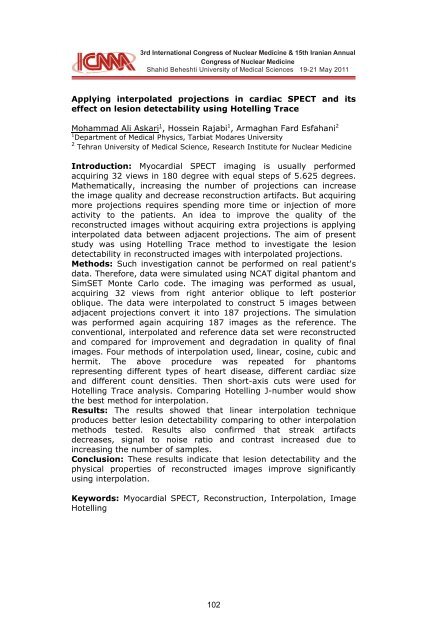Panel Disdussion
Panel Disdussion
Panel Disdussion
You also want an ePaper? Increase the reach of your titles
YUMPU automatically turns print PDFs into web optimized ePapers that Google loves.
3rd International Congress 3rd International of Nuclear Congress Medicine of Nuclear & 15th Medicine Iranian Annual & 15th Iranian Congress Annual of<br />
Nuclear Congress Medicine of Nuclear Medicine<br />
Shahid Beheshti Shahid Beheshti University University of Medical Sciences of Medical 19-21 Sciences May 201119-21 May 2011<br />
Applying interpolated projections in cardiac SPECT and its<br />
effect on lesion detectability using Hotelling Trace<br />
Mohammad Ali Askari 1 , Hossein Rajabi 1 , Armaghan Fard Esfahani 2<br />
1 Department of Medical Physics, Tarbiat Modares University<br />
2 Tehran University of Medical Science, Research Institute for Nuclear Medicine<br />
Introduction: Myocardial SPECT imaging is usually performed<br />
acquiring 32 views in 180 degree with equal steps of 5.625 degrees.<br />
Mathematically, increasing the number of projections can increase<br />
the image quality and decrease reconstruction artifacts. But acquiring<br />
more projections requires spending more time or injection of more<br />
activity to the patients. An idea to improve the quality of the<br />
reconstructed images without acquiring extra projections is applying<br />
interpolated data between adjacent projections. The aim of present<br />
study was using Hotelling Trace method to investigate the lesion<br />
detectability in reconstructed images with interpolated projections.<br />
Methods: Such investigation cannot be performed on real patient's<br />
data. Therefore, data were simulated using NCAT digital phantom and<br />
SimSET Monte Carlo code. The imaging was performed as usual,<br />
acquiring 32 views from right anterior oblique to left posterior<br />
oblique. The data were interpolated to construct 5 images between<br />
adjacent projections convert it into 187 projections. The simulation<br />
was performed again acquiring 187 images as the reference. The<br />
conventional, interpolated and reference data set were reconstructed<br />
and compared for improvement and degradation in quality of final<br />
images. Four methods of interpolation used, linear, cosine, cubic and<br />
hermit. The above procedure was repeated for phantoms<br />
representing different types of heart disease, different cardiac size<br />
and different count densities. Then short-axis cuts were used for<br />
Hotelling Trace analysis. Comparing Hotelling J-number would show<br />
the best method for interpolation.<br />
Results: The results showed that linear interpolation technique<br />
produces better lesion detectability comparing to other interpolation<br />
methods tested. Results also confirmed that streak artifacts<br />
decreases, signal to noise ratio and contrast increased due to<br />
increasing the number of samples.<br />
Conclusion: These results indicate that lesion detectability and the<br />
physical properties of reconstructed images improve significantly<br />
using interpolation.<br />
Keywords: Myocardial SPECT, Reconstruction, Interpolation, Image<br />
Hotelling<br />
102
















